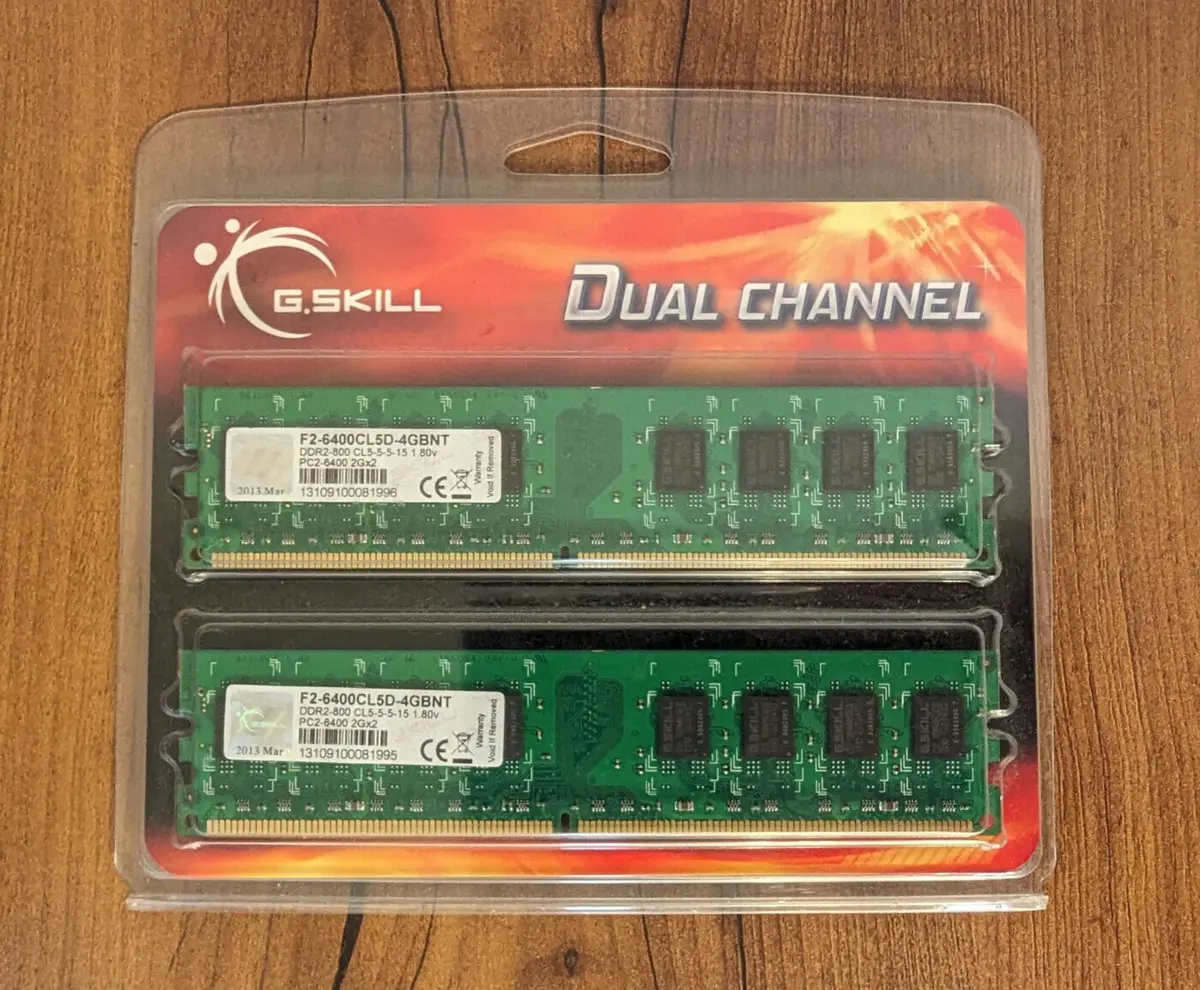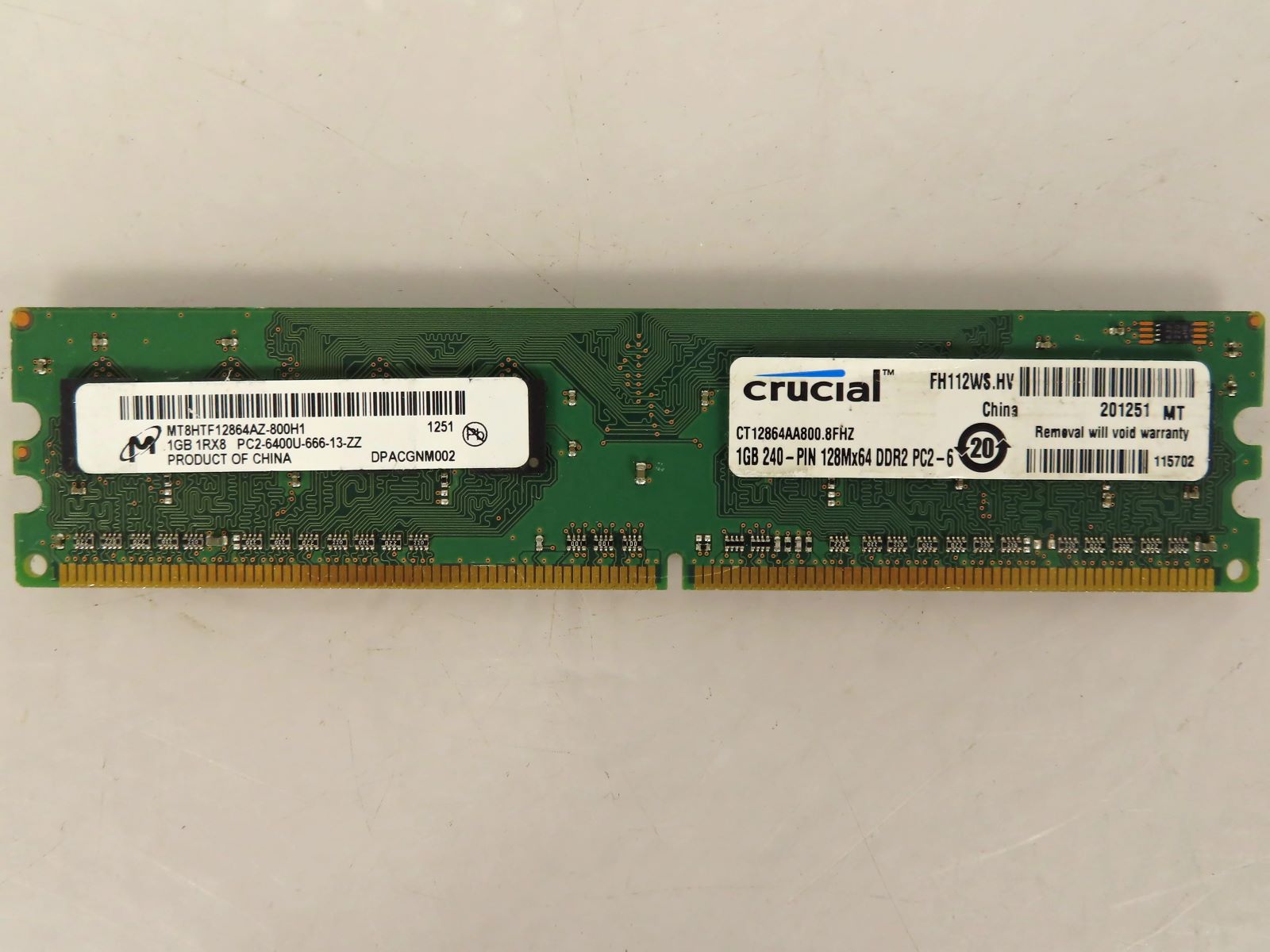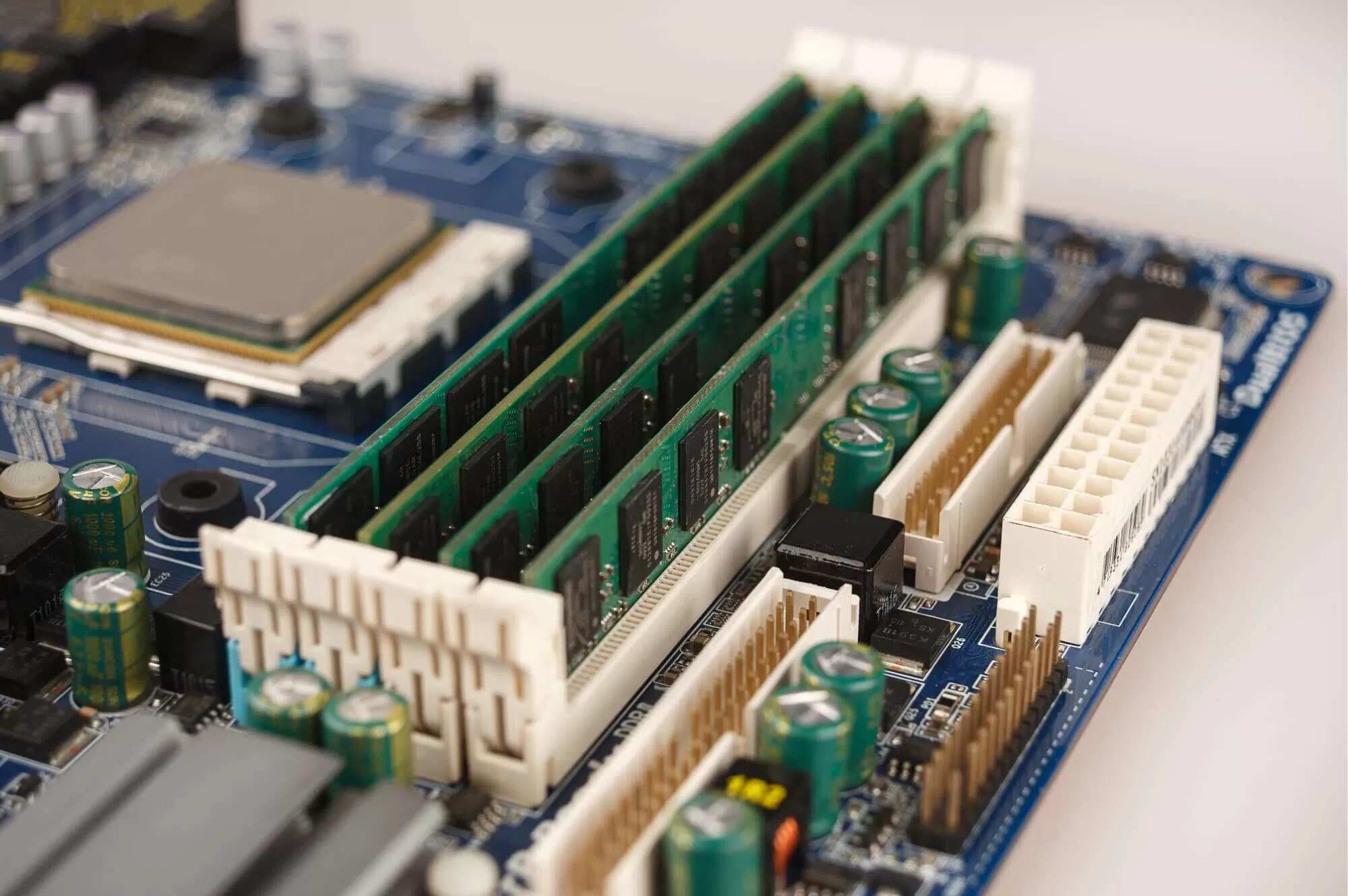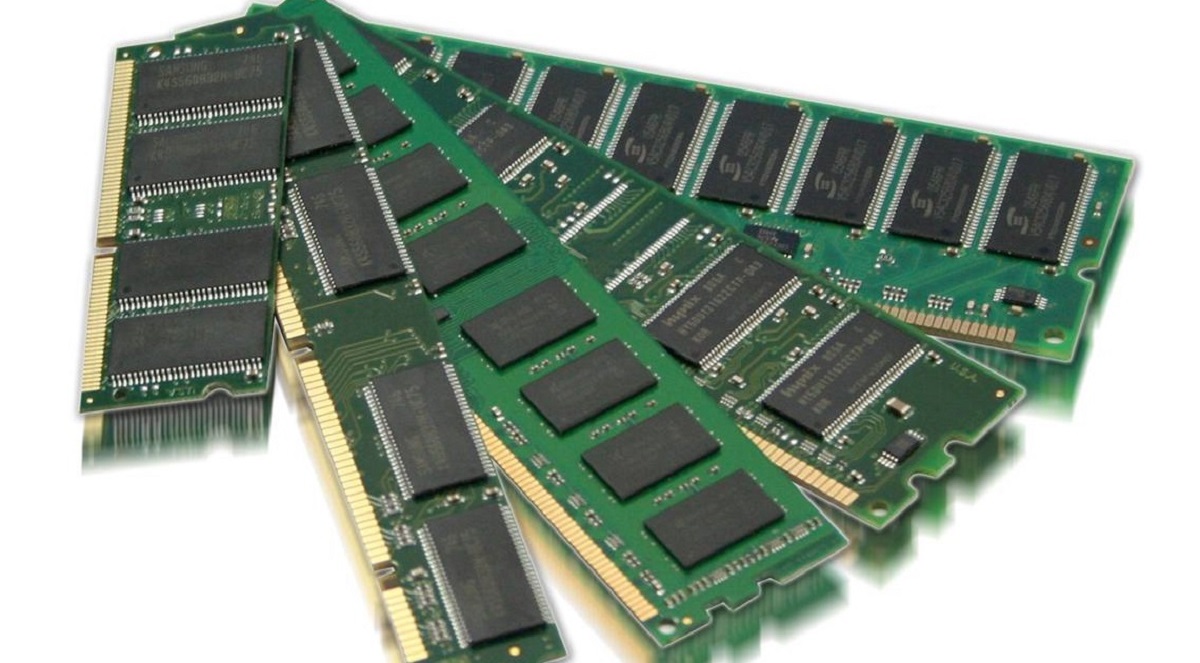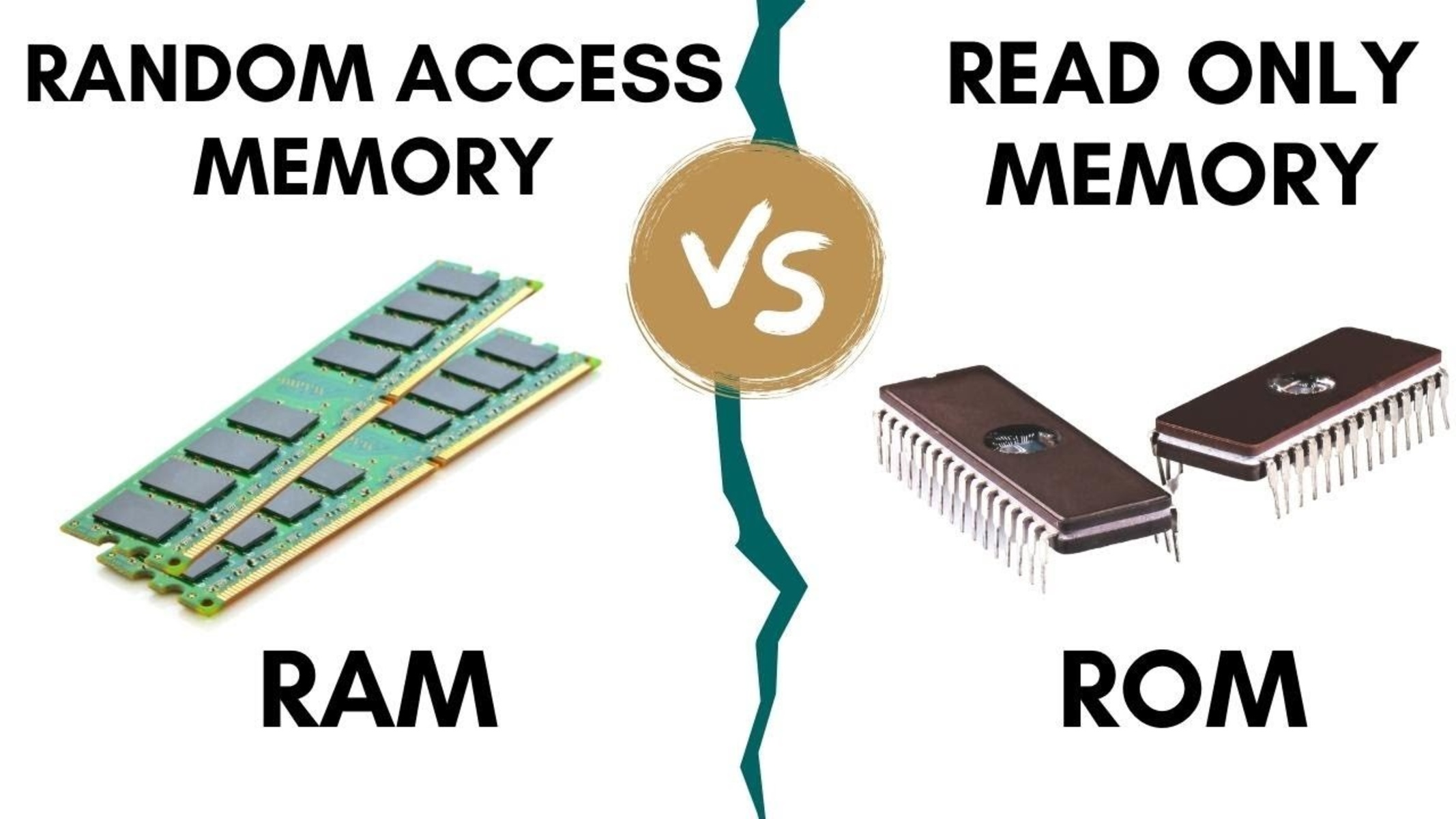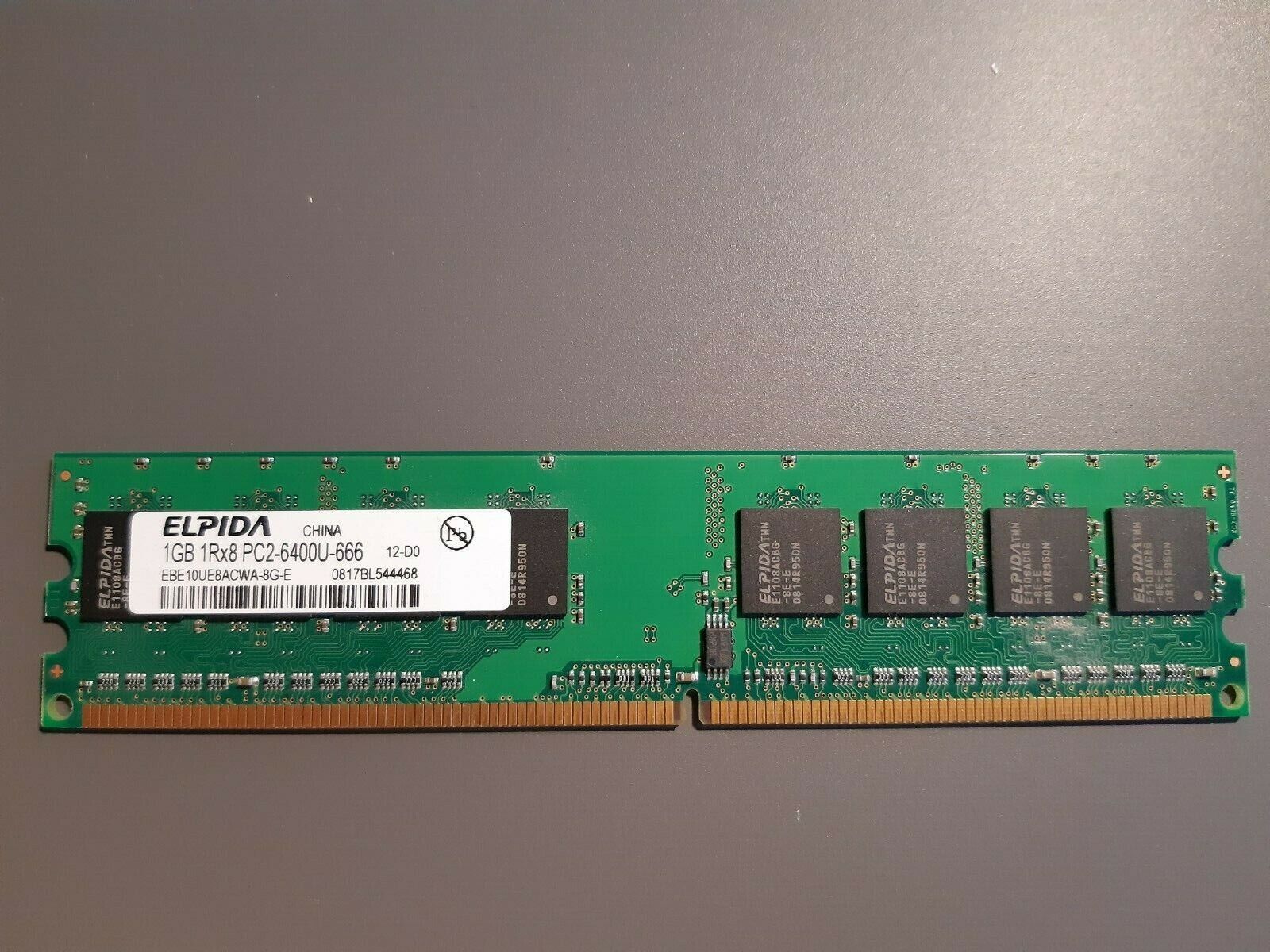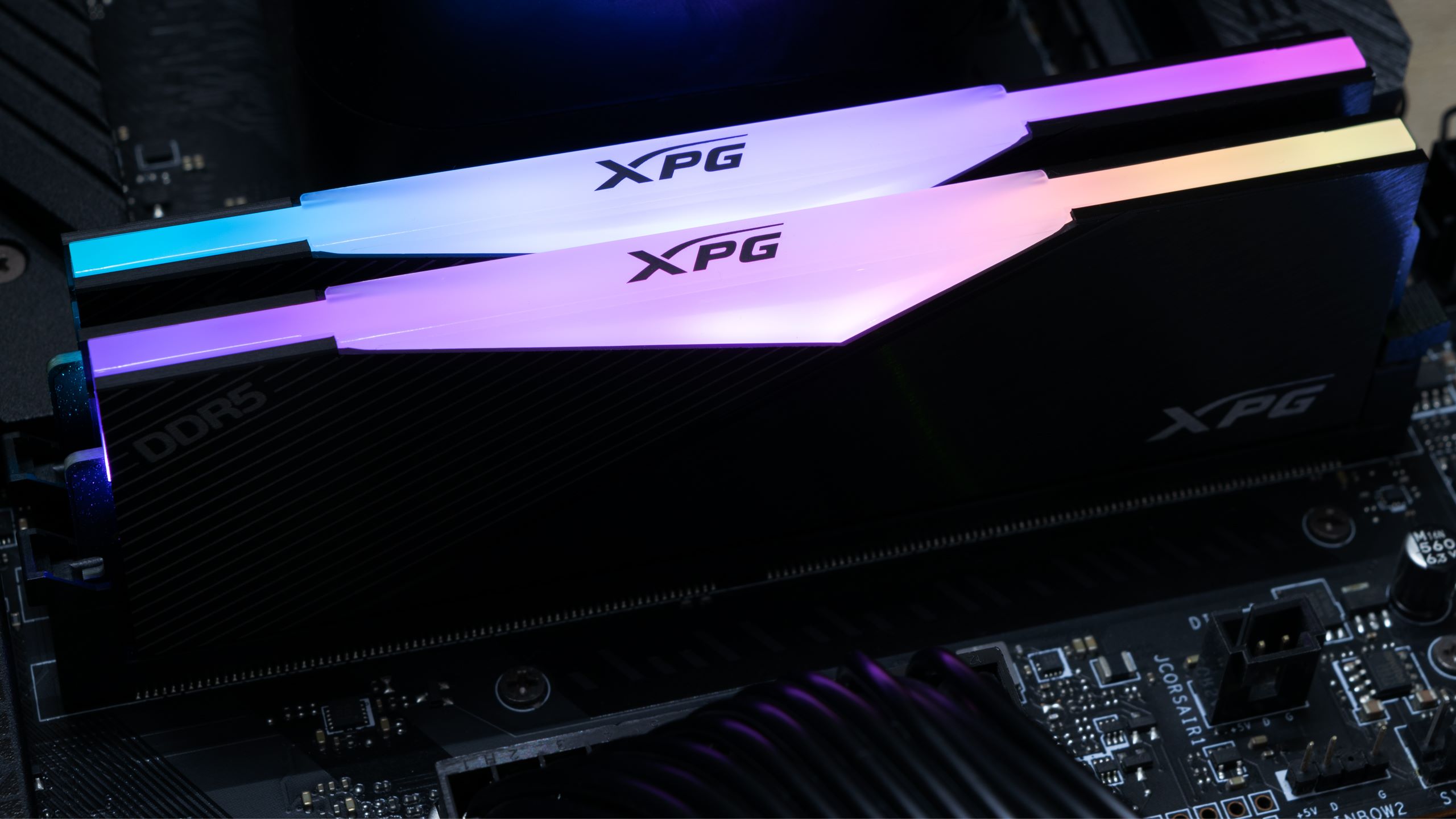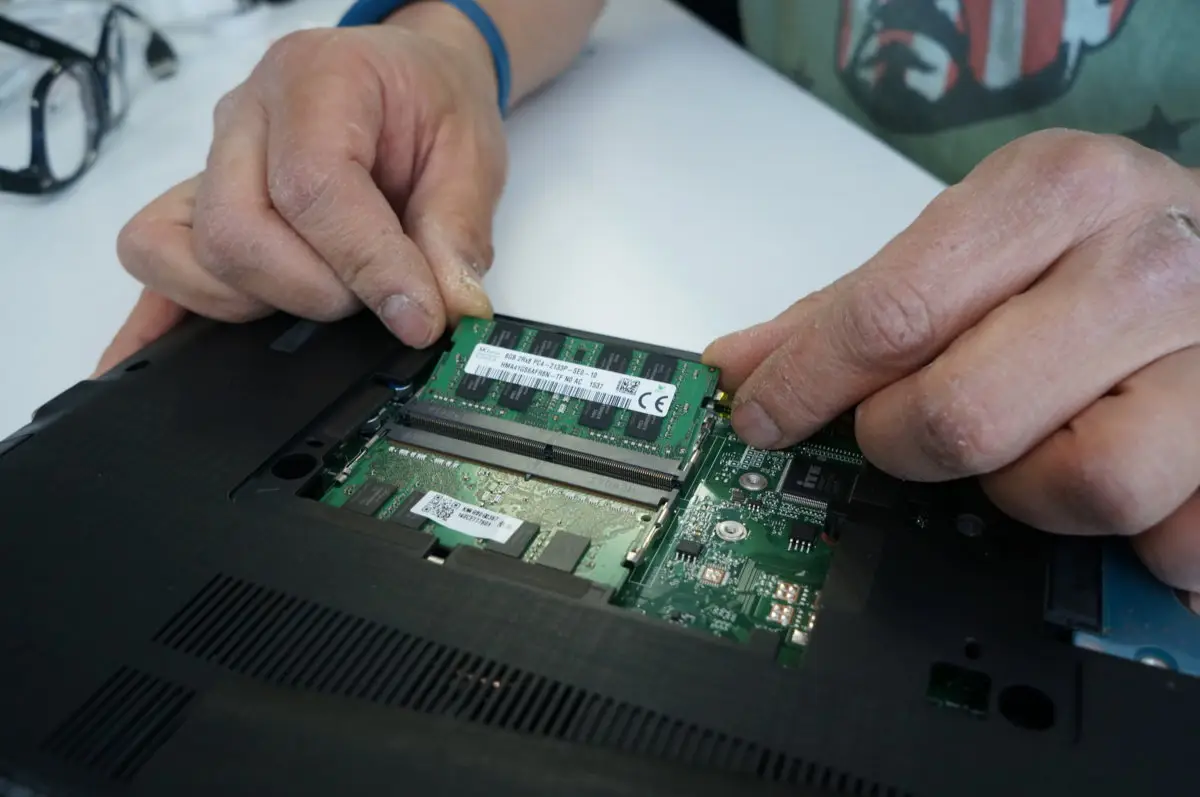Introduction
Welcome to the world of DDR2 RAM! If you are wondering how much DDR2 RAM you can use on your computer, you have come to the right place. DDR2 RAM, or Double Data Rate 2 Random Access Memory, is a type of computer memory that allows for faster data transfer rates compared to its predecessor, DDR1 RAM. It was widely used in computers from the mid-2000s to early 2010s, making it a popular choice during that time.
Understanding the limitations of DDR2 RAM is crucial in optimizing your system’s performance and ensuring compatibility with your hardware and software. In this article, we will explore various factors that can affect the amount of DDR2 RAM you can use, including physical limitations, processor and motherboard compatibility, operating system limitations, and BIOS settings. We will also discuss how to check the DDR2 RAM limit on your system and explore possible solutions to overcome those limitations.
Whether you are a tech enthusiast looking to upgrade your system or simply curious about the capabilities of your DDR2 RAM, this article aims to provide you with all the information you need. Let’s dive in and uncover the world of DDR2 RAM limitations and how to navigate around them!
What is DDR2 RAM?
DDR2 RAM, which stands for Double Data Rate 2 Random Access Memory, is a type of computer memory that was widely used in computers from the mid-2000s to early 2010s. It is an improvement over its predecessor, DDR1 RAM, and offers faster data transfer rates and increased performance.
DDR2 RAM operates at higher clock speeds and has higher bandwidth compared to DDR1 RAM. It uses an advanced technology that allows for the transfer of two chunks of data per clock cycle, hence the “double data rate” designation. This means that DDR2 RAM can transfer data twice as quickly as DDR1 RAM operating at the same clock speed.
DDR2 RAM modules have a different physical design compared to DDR1 RAM. They have 240 pins and require a different type of memory slot on the motherboard. This means that DDR2 RAM is not compatible with motherboards designed for DDR1 RAM, and vice versa.
One of the notable advantages of DDR2 RAM is its higher memory capacity. DDR2 RAM technology allows for larger and denser memory modules to be manufactured. This means that you can have higher amounts of RAM in your system using fewer physical modules.
When it comes to performance, DDR2 RAM offers significant improvements over DDR1 RAM. The increased speed and bandwidth of DDR2 RAM make it ideal for demanding applications such as gaming, video editing, and multitasking. It allows for faster data access and reduces bottlenecking, resulting in smoother and more efficient performance.
It is worth noting that DDR2 RAM is now considered outdated, as newer and faster RAM technologies have been developed. However, there are still many systems out there that use DDR2 RAM, and understanding its capabilities and limitations is essential for optimizing their performance.
Now that we have a better understanding of what DDR2 RAM is, let’s explore the various factors that can affect how much DDR2 RAM you can use on your system.
Understanding RAM Limitations
When it comes to using DDR2 RAM or any type of RAM, there are certain limitations that you need to be aware of. These limitations can impact the amount of RAM you can effectively use on your system and can vary based on several factors. Understanding these limitations will help you make informed decisions when it comes to upgrading your RAM and optimizing your system’s performance.
Physical Limitations: One of the primary limitations of DDR2 RAM is its physical capacity. Each DDR2 RAM module has a specific maximum capacity, commonly ranging from 1GB to 8GB per module. This means that the total amount of DDR2 RAM you can use on your system is limited by the number of RAM slots available on your motherboard and the maximum capacity of each module. For example, if you have four RAM slots on your motherboard and each slot can support a maximum of 2GB DDR2 RAM modules, the maximum RAM capacity you can have is 8GB.
Processor and Motherboard Compatibility: Another factor that affects the RAM limitations is the compatibility between your processor, motherboard, and RAM. Different processors and motherboards have specific limitations when it comes to the supported RAM types, speeds, and capacities. It is important to consult the specifications of your processor and motherboard to ensure compatibility and avoid any potential issues. If your processor or motherboard has a lower maximum supported RAM capacity, it can limit the amount of DDR2 RAM you can effectively use.
Operating System Limitations: The operating system you are using can also impose limitations on the amount of RAM you can utilize. Older operating systems may have a maximum supported RAM capacity, meaning that even if you have a higher amount of DDR2 RAM installed, the system will only recognize and utilize the maximum supported amount. For example, a 32-bit operating system usually has a maximum RAM limit of 4GB, so if you have more than 4GB DDR2 RAM installed, the excess RAM will not be recognized.
32-bit vs 64-bit Operating Systems: It is important to note that 64-bit operating systems offer higher RAM capacity support compared to 32-bit operating systems. While 32-bit operating systems have RAM limitations of 4GB, 64-bit operating systems can support significantly higher amounts of RAM, ranging from 8GB to several terabytes, depending on the specific operating system version and edition. Therefore, if you are planning to use more than 4GB of DDR2 RAM, it is recommended to have a 64-bit operating system installed.
BIOS Limitations: The system’s BIOS (Basic Input/Output System) settings can also impact the RAM limitations. BIOS options such as memory remapping or memory hole settings can affect the addressable memory space and the amount of RAM that can be used by the operating system. It is important to check the BIOS settings to ensure that the maximum amount of DDR2 RAM is being recognized and utilized by the system.
By understanding these various limitations, you can determine the maximum amount of DDR2 RAM you can effectively use on your system. In the next section, we will explore common DDR2 RAM limitations and how to check the DDR2 RAM limit on your system.
Factors Affecting DDR2 RAM Limit
Several factors can affect the limit of DDR2 RAM that you can effectively use on your system. Understanding these factors will help you determine the maximum amount of DDR2 RAM your system can support and utilize. Let’s explore these factors in more detail:
1. Physical Limitations: The physical design of your motherboard and the number of available RAM slots can limit the total amount of DDR2 RAM you can use. Each RAM slot has a maximum capacity, and if you have limited slots on your motherboard or lower capacity modules, it can restrict the overall RAM limit. Additionally, the maximum module capacity supported by your motherboard will also play a role in determining the DDR2 RAM limit.
2. Processor Compatibility: The compatibility between your processor and DDR2 RAM can affect the maximum RAM limit. Processors have specific memory controller capabilities, including limitations on the type, speed, and capacity of RAM they can support. Consult the documentation or specifications of your processor to determine its maximum supported RAM capacity.
3. Motherboard Compatibility: Similar to processors, motherboards have their own compatibility limitations when it comes to DDR2 RAM. The motherboard chipset and memory controller play a vital role in determining the DDR2 RAM capacity. Check the specifications of your motherboard to ensure it supports the DDR2 RAM modules you want to use and can handle the desired memory capacity.
4. Operating System Limitations: The operating system you are using can have limitations on the maximum RAM capacity it can recognize and utilize. Older operating systems, especially 32-bit versions, have limitations due to their memory addressing capabilities. For instance, a 32-bit operating system can typically support up to 4GB of RAM, which means that any additional DDR2 RAM beyond that limit will not be utilized.
5. BIOS Settings: The system’s BIOS settings can impact the DDR2 RAM limit. Certain BIOS options, such as memory remapping or memory hole settings, can affect the addressable memory space and the amount of RAM that the operating system can use. Make sure to check your BIOS settings and ensure they are configured correctly to optimize the DDR2 RAM utilization.
6. Other Hardware Components: Factors beyond RAM itself can affect the DDR2 RAM limit. For example, if you have other hardware components in your system that require memory resources, such as dedicated graphics cards, they can also influence the available RAM capacity. It is important to consider the memory requirements of all components in your system to determine the feasible DDR2 RAM limit.
By taking into account these factors and understanding their impact on DDR2 RAM limitations, you can ensure that you are making informed decisions when it comes to upgrading and optimizing your system’s memory capacity. In the next section, we will explore the physical limitations of DDR2 RAM in more detail.
Physical Limitations of DDR2 RAM
DDR2 RAM, like any other type of RAM, has physical limitations that determine the maximum capacity and configuration of memory modules you can use on your system. Understanding these physical limitations is crucial when it comes to upgrading or expanding the DDR2 RAM on your computer. Let’s take a closer look at these physical limitations:
1. Module Capacity: DDR2 RAM modules have a specific maximum capacity that determines the amount of memory they can hold. Common DDR2 RAM module capacities range from 1GB to 8GB. It is important to check the specifications of your motherboard and consult the documentation of your DDR2 RAM modules to verify the maximum capacity supported by both.
2. Memory Slots: DDR2 RAM modules are inserted into memory slots on your motherboard. The number of memory slots available can determine the overall RAM capacity of your system. For instance, if your motherboard has four memory slots and each slot supports a maximum module capacity of 2GB, the maximum total RAM capacity you can achieve is 8GB.
3. Memory Channel Configuration: DDR2 RAM can operate in single-channel, dual-channel, or even quad-channel configurations. The memory channel configuration depends on the memory controller’s capabilities and the motherboard’s design. Dual-channel and quad-channel configurations offer increased memory performance by parallelizing the data transfer across multiple memory channels. However, the motherboard and memory controller must support these configurations for them to be utilized.
4. Compatibility with Other RAM Technologies: DDR2 RAM is not compatible with other RAM technologies, such as DDR3 or DDR4. Each RAM technology differs in terms of physical design, pin layout, and voltage requirements. As a result, DDR2 RAM modules cannot be used in motherboards designed for newer RAM technologies, and vice versa.
5. Speed and Voltage: DDR2 RAM modules have their own specific speed and voltage requirements. It is essential to ensure that the DDR2 RAM modules you are using are compatible with your motherboard’s supported speed and voltage ranges. Using RAM modules with incompatible speed or voltage can result in instability or even damage to your system.
6. Physical Size: DDR2 RAM modules have a physical size and shape that must match the memory slots on your motherboard. DDR2 RAM modules have 240 pins, and the slots on the motherboard are designed to accommodate this specific pin configuration. Trying to insert DDR2 RAM modules into slots made for a different RAM type can cause damage to the module or the motherboard.
By understanding the physical limitations of DDR2 RAM, you can ensure proper compatibility and optimize your system’s memory configuration. In the next section, we will explore factors that can affect DDR2 RAM limits beyond the physical aspects, such as processor and motherboard compatibility.
Processor and Motherboard Compatibility
When it comes to DDR2 RAM, the compatibility between your processor, motherboard, and RAM modules is crucial for proper functioning and optimal performance. Understanding the compatibility requirements can help you determine the maximum DDR2 RAM capacity and configuration that your system can support. Let’s delve into the factors that influence processor and motherboard compatibility:
Processor Memory Controller: The memory controller is an integral part of the processor that handles the communication between the processor and the RAM modules. Different processors have varying memory controller capabilities, including limitations on the type, speed, and capacity of RAM they can support. It is essential to consult the documentation or specifications of your processor to determine its maximum supported DDR2 RAM capacity.
Motherboard Compatibility: The motherboard acts as the connection point for all hardware components, including the RAM modules. The motherboard chipset and memory controller play a key role in determining the DDR2 RAM capacity and compatibility. It is important to check the specifications of your motherboard to ensure it supports DDR2 RAM and can handle the desired memory capacity.
RAM Speed and Voltage: DDR2 RAM modules have their own specific speed and voltage requirements. The motherboard and processor need to support the desired speed and voltage range of the DDR2 RAM modules you intend to use. Mismatching RAM speed and voltage requirements can result in unstable system performance or even damage to the RAM modules or motherboard.
Memory Slot Configuration: DDR2 RAM modules are inserted into memory slots on the motherboard. The placement and configuration of these memory slots can vary among different motherboards. It is essential to ensure that the number and type of memory slots on your motherboard are compatible with the DDR2 RAM modules you plan to use. For example, if you have DDR2 RAM modules that can operate in a dual-channel configuration, your motherboard must have the required dual-channel memory slots.
Bios Compatibility: The system’s BIOS (Basic Input/Output System) settings can also affect the compatibility between the processor, motherboard, and DDR2 RAM. BIOS updates can sometimes provide improved compatibility with certain RAM modules or increase the maximum supported RAM capacity. Checking for the latest BIOS updates for your motherboard is recommended to ensure optimal DDR2 RAM compatibility.
It is important to note that DDR2 RAM is an older technology, and newer processors and motherboards may not support DDR2 RAM at all. Therefore, if you are considering upgrading your RAM, it is important to check the compatibility of your processor and motherboard with the specific RAM technology you plan to use.
By ensuring proper compatibility between your processor, motherboard, and DDR2 RAM modules, you can maximize system performance and avoid any compatibility issues. In the next section, we will explore the limitations imposed by the operating system.
Operating System Limitations
The operating system you are using plays a significant role in determining the amount of DDR2 RAM your system can effectively utilize. Different operating systems have their own limitations when it comes to recognizing and utilizing RAM, including DDR2 RAM. Let’s explore the operating system limitations that can affect DDR2 RAM usage:
32-bit vs. 64-bit Operating Systems: One of the primary factors that impact RAM limitations is the distinction between 32-bit and 64-bit operating systems. A 32-bit operating system has a maximum addressable memory limit of 4GB. This means that regardless of how much DDR2 RAM you have installed on your system, a 32-bit operating system can only recognize and utilize up to 4GB of RAM. If you have more than 4GB of DDR2 RAM installed, the excess memory will not be utilized by the operating system.
On the other hand, 64-bit operating systems have significantly higher RAM capacity limits. The exact limit can vary depending on the specific version and edition of the operating system, but most 64-bit operating systems can support RAM capacities ranging from 8GB to several terabytes. Therefore, if you want to fully utilize more than 4GB of DDR2 RAM, it is crucial to have a 64-bit operating system installed on your system.
Operating System Version and Edition: The specific version and edition of the operating system can impact the RAM limitations as well. Some versions or editions of an operating system may have lower RAM limits compared to others. It is important to check the specifications of your operating system to determine its maximum supported RAM capacity.
Operating System Updates and Patches: Occasionally, operating system updates and patches can provide improvements or enhancements to the maximum supported RAM capacity. Some updates may resolve compatibility issues or increase the RAM limit. It is recommended to keep your operating system updated to access the latest improvements regarding DDR2 RAM utilization.
It is worth mentioning that DDR2 RAM limitations are not solely determined by the operating system. Other factors, such as physical limitations, processor and motherboard compatibility, and BIOS settings, also come into play. Therefore, it is essential to consider the overall compatibility and limitations of your system before determining the maximum DDR2 RAM capacity you can effectively utilize.
By understanding the limitations imposed by the operating system, you can ensure that your DDR2 RAM is recognized and utilized to its maximum potential. In the next section, we will discuss the impact of BIOS settings on DDR2 RAM limitations.
32-bit vs 64-bit Operating Systems
The choice between a 32-bit or 64-bit operating system has a significant impact on the amount of DDR2 RAM your system can effectively utilize. Understanding the differences between these two operating system architectures will help you make an informed decision and maximize the potential of your DDR2 RAM. Let’s delve into the characteristics of each:
32-bit Operating Systems: A 32-bit operating system has limitations when it comes to RAM capacity. It can address a maximum of 4GB of memory space. This means that even if you have more than 4GB of DDR2 RAM installed on your system, a 32-bit operating system will only be able to recognize and utilize up to 4GB. The memory addressing limitation of 32-bit systems is a result of their address space, which is limited to 32 bits.
64-bit Operating Systems: In contrast, a 64-bit operating system can address significantly higher amounts of memory. It has a theoretical limit of up to 18.4 million TB (terabytes) of RAM. This means that if you have more than 4GB of DDR2 RAM installed, a 64-bit operating system can recognize and effectively utilize the entire capacity. The increased memory capacity of 64-bit systems is due to their expanded address space, which is 64 bits.
However, it is important to note that the actual RAM capacity supported by a 64-bit operating system can vary depending on the specific version and edition, as well as hardware limitations. Some versions of 64-bit operating systems have memory limitations imposed by licensing or hardware constraints.
Having a 64-bit operating system is particularly advantageous when you need to utilize large amounts of DDR2 RAM for memory-intensive applications. Tasks such as video editing, 3D modeling, virtualization, and advanced gaming can greatly benefit from the expanded memory capacity provided by a 64-bit operating system.
When deciding between a 32-bit or 64-bit operating system, it is crucial to consider the compatibility of your hardware components and software applications. Ensure that your processor, motherboard, and drivers are compatible with a 64-bit operating system. Additionally, check the compatibility of your software applications to ensure they are designed to run on a 64-bit architecture.
It is worth mentioning that if your system has limited DDR2 RAM capacity (e.g., 4GB or less), using a 32-bit operating system may still be a viable option. However, if you have more than 4GB of DDR2 RAM and wish to take full advantage of its capabilities, a 64-bit operating system is highly recommended.
By understanding the differences between 32-bit and 64-bit operating systems, you can make an informed decision on which architecture is suitable for your DDR2 RAM capacity and computing needs. In the next section, we will explore the impact of BIOS settings on DDR2 RAM limitations.
BIOS Limitations
The Basic Input/Output System (BIOS) is firmware built into the motherboard of a computer. It is responsible for initializing hardware components and providing system settings that can affect the limitations and functionality of DDR2 RAM. Understanding the potential limitations imposed by the BIOS can help you optimize the utilization of your DDR2 RAM. Let’s explore the impact of BIOS settings on DDR2 RAM limitations:
Memory Remapping: Some BIOS settings allow for memory remapping, which enables the operating system to access memory above the 4GB limit in a 32-bit system. By enabling memory remapping, the BIOS can map the physical memory above the 4GB boundary into the addressable memory space, allowing the operating system to utilize more than 4GB of DDR2 RAM. It is crucial to check the BIOS settings and enable memory remapping if you want to fully utilize larger amounts of DDR2 RAM.
Memory Hole: The BIOS may have settings related to memory holes, which are reserved memory regions used for specific purposes. These memory holes can limit the amount of usable memory by reserving address space for devices or other system operations. Clearing or adjusting memory hole settings in the BIOS can help optimize the available DDR2 RAM capacity.
Compatible RAM Configurations: The BIOS may impose restrictions on the configuration of DDR2 RAM modules. For example, it may limit the maximum supported module capacity or limit the memory channel configurations. It is important to consult the motherboard’s documentation or BIOS settings to ensure that your desired DDR2 RAM configuration is supported and can be properly accessed by the system.
BIOS Updates: Manufacturers often release BIOS updates to improve compatibility with newer technologies or address issues with DDR2 RAM recognition and utilization. It is recommended to regularly check for and install any available BIOS updates for your motherboard to ensure optimal DDR2 RAM performance and compatibility. Updates may include enhancements in RAM support, bug fixes, or improvements to memory timings and compatibility.
Understanding and adjusting the appropriate BIOS settings can help overcome certain limitations and optimize DDR2 RAM utilization. However, it is important to exercise caution when modifying BIOS settings, as incorrect configurations can lead to system instabilities or even cause the system to fail to boot. If you are unsure about a specific BIOS setting, it is advisable to consult the motherboard or system manufacturer’s documentation or seek assistance from a knowledgeable professional.
By familiarizing yourself with the BIOS limitations and settings related to DDR2 RAM, you can optimize your system’s memory utilization and ensure more efficient performance. In the next section, we will explore common DDR2 RAM limitations that users may encounter.
Common DDR2 RAM Limitations
While DDR2 RAM has its advantages, there are several limitations that users may encounter. Being aware of these common limitations can help you make informed decisions when it comes to upgrading or optimizing your DDR2 RAM. Let’s discuss some of the common DDR2 RAM limitations:
Maximum RAM Capacity: One of the primary limitations of DDR2 RAM is its maximum capacity. Each DDR2 RAM module has a specific maximum capacity, commonly ranging from 1GB to 8GB per module. The total RAM capacity you can have on your system is limited by the number of RAM slots available on your motherboard and the maximum capacity of each module. For instance, if you have two RAM slots and each slot supports a maximum of 4GB DDR2 RAM modules, the maximum RAM capacity you can have is 8GB.
Physical Compatibility: DDR2 RAM is not physically compatible with other RAM technologies, such as DDR3 or DDR4. The physical design and pin configuration of DDR2 RAM modules differ from newer RAM technologies. Therefore, it is important to ensure that your motherboard and other hardware components are compatible with DDR2 RAM before making any upgrades or changes to your system.
Processor and Motherboard Compatibility: The compatibility between your processor, motherboard, and DDR2 RAM can impact the maximum RAM capacity. Each processor and motherboard has specific limitations when it comes to the supported RAM types, speeds, and capacities. It is important to consult the documentation or specifications of your processor and motherboard to ensure compatibility and avoid any potential issues that may arise when using DDR2 RAM.
Operating System Limitations: The operating system you are using can impose limitations on the amount of RAM you can effectively utilize. Older operating systems, especially 32-bit versions, have limitations due to their memory addressing capabilities. A 32-bit operating system can typically support up to 4GB of RAM, meaning that any additional DDR2 RAM beyond that limit will not be recognized or utilized. Upgrading to a 64-bit operating system can overcome this limitation and allow you to utilize larger amounts of DDR2 RAM.
Performance Limitations: While DDR2 RAM was a significant improvement over its predecessor, DDR1 RAM, it is still considered outdated compared to newer RAM technologies, such as DDR3 and DDR4. The slower speeds and lower bandwidth of DDR2 RAM can limit the overall system performance, especially when running memory-intensive tasks or applications. If you require higher performance, it may be beneficial to consider upgrading to a newer RAM technology.
Understanding these common limitations can help you determine the optimal DDR2 RAM configuration for your system and avoid any compatibility or performance issues. By working within the constraints of DDR2 RAM, you can still achieve efficient and reliable system performance for everyday computing tasks.
In the next section, we will explore how to check the DDR2 RAM limit on your system to ensure proper configuration and utilization.
How to Check DDR2 RAM Limit on Your System
If you want to determine the maximum DDR2 RAM limit on your system or find out how much DDR2 RAM is currently installed, there are several methods you can use. Let’s explore some of the common ways to check the DDR2 RAM limit on your system:
1. Task Manager (Windows): On a Windows operating system, you can use the built-in Task Manager utility to check the installed RAM and its maximum capacity. To access Task Manager, press Ctrl+Shift+Esc or right-click on the taskbar and select “Task Manager.” In the Task Manager window, navigate to the “Performance” tab, where you can find the “Memory” section. Here, you can see the total installed RAM (physical memory) and the maximum capacity supported by the operating system.
2. System Information (Windows and macOS): Another method is to use the System Information utility, available in both Windows and macOS operating systems. To access System Information on Windows, press the Windows key + R, then type “msinfo32” and press Enter. In the System Information window, you can find the “Installed Physical Memory” field, which displays the total RAM installed on your system. On macOS, click on the Apple menu, select “About This Mac,” and go to the “Overview” or “Memory” tab to view the installed RAM information.
3. Command Prompt or Terminal: Command Prompt (Windows) or Terminal (macOS and Linux) allows you to view system information, including RAM details. In Windows, open Command Prompt by pressing Windows key + R, then type “cmd” and press Enter. In the Command Prompt window, type “wmic memorychip get Capacity” and press Enter to view the capacity of each RAM module installed. On macOS or Linux, open Terminal and enter the command “cat /proc/meminfo | grep MemTotal” to see the total installed RAM.
4. BIOS Settings: The BIOS settings on your motherboard can also provide information about the DDR2 RAM limit. To access the BIOS settings, restart your computer and look for on-screen prompts during the boot process. The BIOS setup screen may display the maximum RAM capacity supported by your motherboard or provide detailed information about the installed RAM modules.
By using these methods, you can check the DDR2 RAM limit on your system and determine the maximum capacity or currently installed RAM. This information will help you make informed decisions when it comes to upgrading or optimizing your DDR2 RAM configuration.
Remember that these methods are general guidelines, and the actual steps may vary depending on your specific operating system, hardware, and BIOS configuration. It is always recommended to consult the documentation or support resources for your particular system or motherboard for accurate and detailed information regarding DDR2 RAM limitations.
In the next section, we will explore possible options to overcome DDR2 RAM limitations and upgrade your system’s memory capacity.
Overcoming DDR2 RAM Limitations
If you find that the DDR2 RAM limitations on your system are hindering its performance or preventing you from running memory-intensive tasks, there are several options you can consider to overcome these limitations. Let’s explore some possible solutions:
1. Upgrade the RAM Modules: The most straightforward solution is to upgrade your DDR2 RAM modules to higher-capacity ones. Depending on the limitations of your motherboard, you can replace the existing modules with larger-capacity modules. For example, if you currently have 1GB modules installed, you may be able to replace them with 4GB modules. Ensure that the modules you choose are compatible with your motherboard and meet the required specifications.
2. Utilize All Available RAM Slots: If your motherboard has additional vacant RAM slots, you can install additional DDR2 RAM modules to increase the total RAM capacity. For example, if you have two slots and only one module installed, adding another module of the same capacity will effectively double your RAM capacity. Consult your motherboard’s documentation to determine the maximum number of RAM slots and the supported memory configurations.
3. Memory Channel Configuration: If your motherboard supports dual-channel or quad-channel memory configurations, make sure that you have properly matched DDR2 RAM modules installed in the corresponding memory slots. This can improve memory bandwidth and performance, particularly when running memory-intensive applications.
4. Upgrade the Motherboard: If your current motherboard is outdated and restricts the maximum supported DDR2 RAM capacity, you may consider upgrading to a newer motherboard that supports higher capacity RAM modules. This will provide you with greater flexibility in terms of DDR2 RAM options and expand your system’s overall memory capacity. Ensure that the new motherboard is compatible with your other hardware components.
5. Upgrade to a 64-bit Operating System: If you are currently using a 32-bit operating system and have more than 4GB of DDR2 RAM installed, upgrading to a 64-bit operating system is essential to fully utilize the available RAM. A 64-bit operating system can address larger memory capacities and enable your system to recognize and effectively utilize the excess RAM beyond the 4GB limit imposed by 32-bit systems.
6. Consider Upgrading to a Newer RAM Technology: While upgrading to higher-capacity DDR2 RAM modules can improve your system’s performance, it may eventually reach its maximum potential due to the limitations of DDR2 technology. In such cases, it might be worth considering upgrading to a newer RAM technology, such as DDR3 or DDR4. These newer technologies offer higher speeds, increased bandwidth, and larger maximum capacities, allowing for even better performance and future expandability.
Before making any upgrades, it is important to research and ensure compatibility between your hardware components, including the motherboard, processor, and RAM modules. Consult the documentation, specifications, and support resources for your specific system to determine the best upgrade options that will suit your needs.
By overcoming DDR2 RAM limitations, you can enhance your system’s performance and ensure smoother multitasking and efficient usage of memory-intensive applications.
In the next section, we will conclude our exploration of DDR2 RAM and its limitations, highlighting the key points discussed throughout the article.
Upgrade Options for DDR2 RAM
When it comes to upgrading DDR2 RAM, there are several options to consider that can help improve your system’s performance and memory capacity. Let’s explore some of the upgrade options available:
1. Replace Existing Modules: If your current DDR2 RAM modules have low capacities, you can upgrade them by replacing them with higher-capacity modules. For example, if you have 1GB modules, you can replace them with 4GB modules to significantly increase your system’s memory capacity. Ensure that the new modules are compatible with your motherboard and adhere to the supported specifications, such as speed and voltage.
2. Add More RAM Modules: If your motherboard has vacant RAM slots, you can increase your system’s memory capacity by adding more DDR2 RAM modules. By utilizing all available slots, you can effectively expand the RAM capacity. Ensure that the modules you add are compatible with the existing modules and match the specifications required by your motherboard.
3. Match Memory Channel Configuration: If your motherboard supports dual-channel or quad-channel memory configurations, make sure to match the memory channel configuration with compatible DDR2 RAM modules. This enables your system to take advantage of the increased memory bandwidth and enhances overall performance.
4. Upgrade to a Newer RAM Technology: While DDR2 RAM served as a reliable technology in the past, it is now considered outdated. If you are looking for even better performance and future-proofing, you may consider upgrading to a newer RAM technology like DDR3 or DDR4. These newer technologies offer higher speeds, improved energy efficiency, and larger maximum capacities, providing a significant boost to your system’s performance.
5. Consider Upgrading the Motherboard: If your system requirements go beyond the limitations of DDR2 RAM and you need a more substantial upgrade, you might consider replacing the motherboard altogether. Upgrading the motherboard allows for compatibility with newer RAM technologies and provides more flexibility in terms of memory capacities and configurations. However, keep in mind that a motherboard upgrade may also necessitate other component upgrades, such as the processor and system cooling.
6. Upgrade to a 64-bit Operating System: To fully utilize higher amounts of DDR2 RAM, it is crucial to have a 64-bit operating system. Upgrading from a 32-bit to a 64-bit operating system enables your system to address and utilize RAM capacities beyond the 4GB limit imposed by 32-bit systems. Make sure to check the compatibility of your hardware and software with the specific 64-bit operating system you plan to install.
Before proceeding with any upgrades, thoroughly research and ensure compatibility between the new RAM modules, motherboard, processor, and other hardware components. Consult the documentation, specifications, and support resources for your specific system to determine the best upgrade options available.
Upgrading DDR2 RAM can significantly enhance your system’s performance, improve multitasking capabilities, and allow for smoother execution of memory-intensive applications. By carefully considering your requirements, budget, and compatibility, you can make informed decisions and choose the most suitable upgrade option for your needs.
With this information, you are now equipped to make the right decisions regarding DDR2 RAM upgrades. Remember to evaluate your system’s compatibility, performance needs, and long-term goals when considering any upgrade options.
Conclusion
In conclusion, DDR2 RAM is a type of computer memory that was widely used in systems from the mid-2000s to early 2010s. While DDR2 RAM offered increased performance and faster data transfer compared to its predecessor, it does have certain limitations that need to be considered. Understanding these limitations is crucial for optimizing system performance and ensuring compatibility with hardware and software.
We discussed various factors that can affect the DDR2 RAM limit, including physical limitations such as module capacity, processor and motherboard compatibility, operating system limitations, and BIOS settings. These factors determine the maximum amount of DDR2 RAM that can be effectively utilized on a system.
Methods to check DDR2 RAM limit on a system were also explored, including using system utilities like Task Manager, System Information, and the command prompt or terminal, as well as checking BIOS settings. These methods offer insights into the installed DDR2 RAM capacity and allow for better decision-making regarding upgrades.
To overcome the limitations of DDR2 RAM, several upgrade options were discussed. These options include replacing or adding more DDR2 RAM modules, ensuring memory channel configuration compatibility, upgrading to a newer RAM technology, considering a motherboard upgrade, and switching to a 64-bit operating system.
By considering these upgrade options and understanding the compatibility and performance requirements of your system, you can make informed decisions to enhance the performance and memory capacity of your computer.
It is important to note that DDR2 RAM is now considered outdated, and newer RAM technologies like DDR3 and DDR4 provide even higher performance and increased memory capacity. Therefore, when considering upgrades, it is essential to evaluate the overall suitability and compatibility with the latest technologies available.
We hope this article has provided valuable insights into DDR2 RAM and its limitations, as well as guidance on how to overcome these limitations. By optimizing DDR2 RAM utilization, you can unlock the full potential of your system and enjoy improved performance for a wide range of computing tasks.







